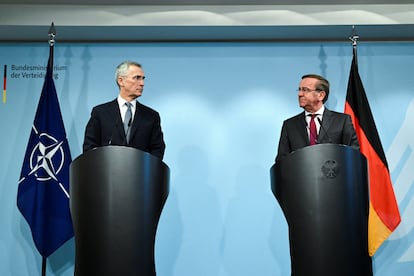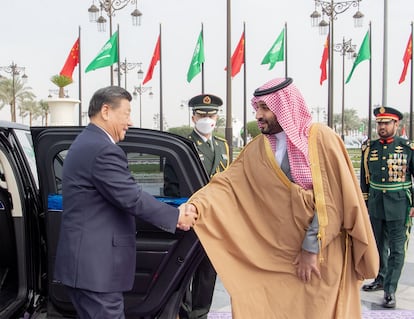A new Cold War between the US and China is spreading around the world
The competition between the two powers – each seeking global hegemony – is increasing pressures, risks and opportunities for other countries

“Russia is the storm; China is climate change.” This metaphor – evoked in October 2022 by the head of Germany’s domestic intelligence service – is, indisputably, an accurate portrait of the reality faced by the world in a turbulent geopolitical atmosphere.
The current global crisis may have been caused by the Russian invasion of Ukraine – which has focused international attention for nearly a year – but the main driving force of the 21st century is the ongoing competition between the United States and China.
The incursion into US airspace of a Chinese balloon – which Washington claims was part of a broader program to spy on military installations around the world – represents a striking reminder that, despite the signals of détente issued at the Bali G-20 summit this past November, the two powers are clearly engaged in a battle for global supremacy. The wingspan of this new Cold War has stretched across the breadth of the planet.
Several recent events show how, regardless of what the two superpowers do internally – such as seeking to strengthen their military, technological or economic muscle – or in their bilateral relationships, both are operating to advance their international position in a multitude of ways.
Tensions have been increasing for some time. According to an exclusive by the Financial Times, last year China Mobile and China Telecom withdrew from the South East Asia-Middle East-West Europe 6 (Sea-Me-We 6) submarine cable project, after the American firm SubCom was selected to build the cable over Hengtong Marine – China’s principal fiber-optic cable manufacturer. Earlier this year, the Philippines granted the Pentagon access to another four of its military bases. Meanwhile, Japan and the Netherlands have gone along with US restrictions on microchip exports to China, while Tokyo and Washington have expanded their defense alliance to include outer space.
In the summer of 2022 – at a G-20 summit attended by four Asia-Pacific countries – the US managed to get NATO to include China in its strategic concept, specifically with the purpose of maligning Chinese activities. It was decided that Taiwan would receive new military financing from the American government, while Australia and the United Kingdom committed to expanding their cooperation on nuclear-powered submarines to include hypersonic weapons.
China, meanwhile, signed a strategic statement affirming an “unconditional” relationship with Russia just before the invasion of Ukraine. And then, in December of 2022, President Xi Jinping carried out a significant visit to Riyadh, Saudi Arabia, intent on strengthening ties with the oil-rich kingdom, whose relationship with Washington is deteriorating. The month before the trip to meet Mohammad Bin Salman, the Chinese president received German Chancellor Olaf Scholz in Beijing. This meeting symbolized China’s efforts to prevent Europe from completely aligning itself with the US.
The Chinese government has also been attempting to reformulate its Belt and Road Initiative – sometimes referred to as the New Silk Road – an ambitious infrastructure project stretching from Western China to Western Russia, which has lost steam in recent years.

“We’re in a kind of Cold War. We’re witnessing a great strategic competition between the US and China, who are not only playing on their own board, but on the global one,” notes Alicia García Herrero, the chief economist for Asia at the French investment bank Natixis and a senior researcher at Bruegel, a Brussels-based economic think tank.
“Thinking that the waters would calm down just because they [Presidents Biden and Xi] met in Bali and signalled that they wanted to lower the temperature was very naive. I think we’ve entered a new reality and it’s not going to change. We’re here not only because the US is tightening its tariffs or restrictions on exports to China, but because [both countries] have an agenda that points towards tough competition.”
“There’s a growing consensus that we’re facing a Second Cold War,” says Jorge Heine, Professor of International Relations at Boston University’s Pardee School of Global Studies. “It’s a notion that I’ve held since at least 2020. At the time, [this position] was criticized by several colleagues, who saw it as premature, considering that there was only a commercial-technological conflict, but without ideological-military overtones. It’s now becoming increasingly apparent that the conflict does have the latter elements – the notion is now widely accepted.
“Of course, there are differences between this Second Cold War and the first, above all due to the size of the Chinese economy and the interdependence between the two countries. There are important differences, but, in many more ways, the [cold wars] are similar. And there are no signs that it will change in the immediate future,” says Heine, who once served as Chile’s ambassador to China.
Mikko Huotari, executive director of the Berlin-based Mercator Institute for China Studies, agrees that, while there are differences, strong similarities with the First Cold War are evident, “from elements of a nuclear arms race to aspects of an ideological competition. We’ve entered a territory of low intensity conflict.”
Here’s a look at how the rivalry between the two giants is playing out on the world map:
Indo-Pacific
This region is the object of intense activity on the part of both countries. The US has been strengthening ties with its allies – as demonstrated by the establishment of the Aukus alliance – which will allow Australia to have a fleet of nuclear-powered submarines. There is also growing support for Taiwan, an expansion of a US-Japanese alliance to tackle the domain of space, as well as increased American access to military bases in the Philippines.
“The US high command is signalling that the next few years will see the biggest military changes in decades,” Huotari says. But Washington is acting on different levels. Heine underlines the attempt to bring strategic positions closer to India – another giant with the ability to define the balance of power.
“In the first decade of this century, the United States was focused on the war against terrorism. Obama already tried to change that, with what he called the pivot towards Asia,” Heine notes. “This shift struggled to take hold – the Middle East continued to demand attention from Washington. But, little by little, [the situation] has evolved. In this vision, India has an important role.”
The logic is obvious, given the size of India and its issues with China. Washington has been trying to cultivate this relationship for years, with a clear rapprochement between former president Donald Trump and Indian Prime Minister Narendra Modi. There have been other attempts, from the Quadrilateral Security Dialogue forum (QUAD, together with Japan and Australia) and, most recently, by the Biden administration, labelling India as a friendly country and urging US companies to redirect their production towards it and reduce reliance on Chinese manufacturing. Apple, for instance, is working on this: production in India and Vietnam has increased.
However, according to Heine, this shift has its limitations. “Firstly, because the Indian economy is much smaller than the Chinese one; secondly, because New Delhi is not integrated into the regional cooperation mechanisms. Also, I doubt that [India’s] attraction as a potential manufacturing relocation destination is superior to what China offers in terms of infrastructure investment and trade. The US market is closed. Decoupling from China may gain momentum in the long term but not in the short term. It’s very difficult to prepare the workforce, the logistics…”
China, for its part, is cultivating the relationships it has with its partner countries, such as Pakistan. Beijing is trying to cement relations via investments as part of the New Silk Road. One such project is an important railway line that has been built in Laos.
The struggle to get closer to countries that are not clearly aligned – such as Indonesia – is intense. Senior officials from the US and China often pay visits to Jakarta. In some countries, there is considerable fluctuation in public opinion. A survey carried out by the Yusof Ishak Institute of Singapore – within the framework of ASEAN, an organization that brings together a dozen Southeast Asian nations – detected an increase in confidence toward the US and greater suspicion towards China: 61% of citizens would opt for Washington and 39% for Beijing “if ASEAN were forced to choose.” In 2022, the ratio was 57% to 43%. Cambodia and Laos also recorded a strong shift away from Beijing.

European Union / NATO
The European Union (EU) – the third-largest global economic player after the United States and China – is fundamental in this clash of the titans. Washington is pushing for its European partners to support its policy towards Beijing, both in the EU dimension and in that of NATO. However, there are many voices in Europe that advocate good relations with China. The differences between partner countries can make management difficult.
Some – such as those on the Eastern flank of the EU and NATO – consider a close relationship with the US as the only guarantor against the Russian threat. For this reason, they’re willing to follow the tough policies that Washington proposes towards Beijing. But others – especially Germany – are wary of a drift that could have a very serious impact on their commercial interests.
“The German government clearly considers it opportune to try to avoid a world of blocs, with the G-7 on one hand and China and Russia on the other. In that sense, I think there’s a certain harmony with Paris, and also with Rome and Madrid,” Huotari says.
Beijing is trying to take advantage of this trump card. The EU has a strong dependence on China for the supply of strategic raw materials, as well as essential products in the green transition, such as solar panels.
Faced with this situation, the European Commission seeks to chart its own path. It’s working on a plan to guarantee greater autonomy in terms of strategic raw materials. Additionally, EU leadership eschews the American language of decoupling with China and proposes a more balanced approach, one based on risk-reduction.
Last summer, the US managed to get NATO to include China in its strategic concept for the first time. However, due to the resistance of European allies, the reference was less forceful than Washington had hoped for.
“There’s an attempt in the Atlantic community to have a certain degree of cohesion not only in rhetoric, but also in institutional action. Steps have been taken in that direction, but it won’t be enough. The push by the United States, for example, [on the subject of] export control, will create an environment of friction that will not be easy to navigate,” Huotari observes.
“Unfortunately, I’m afraid that, in Europe, we’re puppets of this strategic competition. We’re much more vulnerable and, therefore, we don’t have a real option to fully decide where we are between the two [giants],” opines García Herrero. The analyst asks us to consider the deficits that the European bloc suffers from in essential matters, such as security, digital and green technologies, or even in traditional industrial areas.
“We’ve been so concerned with defending ourselves – that is, with protecting the balance of the single market, competition, the balance between member countries, etc. – that we’ve forgotten about competition from outside Europe. It almost seems that we forget that we’re part of the world,” she points out.

The rest of the world
The US has a clear advantage over China, thanks to a dense network of alliances woven for decades with dozens of countries that are, today, among the most-developed in the world. These include some of the thirty countries that make up NATO and Asia-Pacific partners such as Japan, South Korea and Australia.
Beijing is responding with two major lines of action: firstly, with the building of a close relationship with Russia – a country with which it shares the desire to reformulate a world order they both perceive as dominated by the United States and its partners. However, the brutal war launched against Ukraine – and the Russian weaknesses it has exposed – call into question the future value of the relationship, although Beijing is reaping the benefit of cheap energy along the way, as it buys up massive Russian oil and gas supplies.
Secondly, Beijing may have certain advantages over Washington in vast areas of the world, including in dozens of countries in Africa, Latin America and the Middle East. These are areas neglected by the US – many are suspicious of the leading world power, due to Washington’s shady past actions. Many of these countries aren’t interested in receiving lessons on democracy, the rule of law or gender equality. Instead, these governments prefer funding to foster infrastructure and economic development.
“China has long understood that there are large areas of the world with an enormous need for financing for development. International institutions did not adequately cover that need and that the discourses of democracy were of much less interest than the money to build roads, ports and railways. Through this economic path, [China] has been building political relations,” Heine explains.
It is not, however, a smooth road. “I think that China had a clear advantage in this area in the past decade but the scenario has changed a bit. First of all, because the large investments have contracted,” Huotari notes. Funding for projects under the Belt and Road Initiative has slowed considerably, due to a mix of issues linked to the pandemic, China’s economic difficulties and the failure of some of the programme’s projects. Beijing is currently trying to learn from what hasn’t worked.
“In addition,” Huotari continues, “the US and the EU have launched projects to compete. They’re moving slowly, but there’s some coordination. It can be said that distance is being cut – there will be non-stop competition.”
China has turned to more classic diplomatic strategies to regain ground. Xi Jinping’s visit to Riyadh in December was a powerful symbol of a desire to break through on the weak flanks of Washington, whose relationship with its old Arab ally is going through very trying times.
It’s difficult to find corners of the globe where the tremor of the titans goes undetected. There is, however, one spot in particular that has the potential to turn this new Cold War into a hot one: Taiwan. Only time will tell what happens there.
Sign up for our weekly newsletter to get more English-language news coverage from EL PAÍS USA Edition
Tu suscripción se está usando en otro dispositivo
¿Quieres añadir otro usuario a tu suscripción?
Si continúas leyendo en este dispositivo, no se podrá leer en el otro.
FlechaTu suscripción se está usando en otro dispositivo y solo puedes acceder a EL PAÍS desde un dispositivo a la vez.
Si quieres compartir tu cuenta, cambia tu suscripción a la modalidad Premium, así podrás añadir otro usuario. Cada uno accederá con su propia cuenta de email, lo que os permitirá personalizar vuestra experiencia en EL PAÍS.
¿Tienes una suscripción de empresa? Accede aquí para contratar más cuentas.
En el caso de no saber quién está usando tu cuenta, te recomendamos cambiar tu contraseña aquí.
Si decides continuar compartiendo tu cuenta, este mensaje se mostrará en tu dispositivo y en el de la otra persona que está usando tu cuenta de forma indefinida, afectando a tu experiencia de lectura. Puedes consultar aquí los términos y condiciones de la suscripción digital.
More information
Archived In
Últimas noticias
David Bowie, the galactic thinker who encouraged us to break new ground
John Berger and the loss of rural culture
From police officer to bloodthirsty kidnapper: Terror in Mexico during the years of ‘The Ear Chopper’
Alain Aspect, Nobel laureate in physics: ‘Einstein was so smart that he would have had to recognize quantum entanglement’
Most viewed
- David King, chemist: ‘There are scientists studying how to cool the planet; nobody should stop these experiments from happening’
- Reinhard Genzel, Nobel laureate in physics: ‘One-minute videos will never give you the truth’
- Oona Chaplin: ‘I told James Cameron that I was living in a treehouse and starting a permaculture project with a friend’
- Mexico completes its trade shift with the entry into force of tariffs on China and countries without trade agreements
- Sinaloa Cartel war is taking its toll on Los Chapitos










































